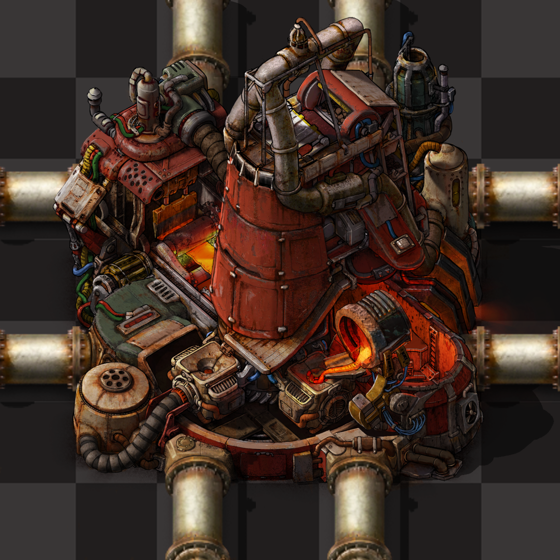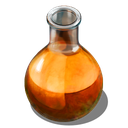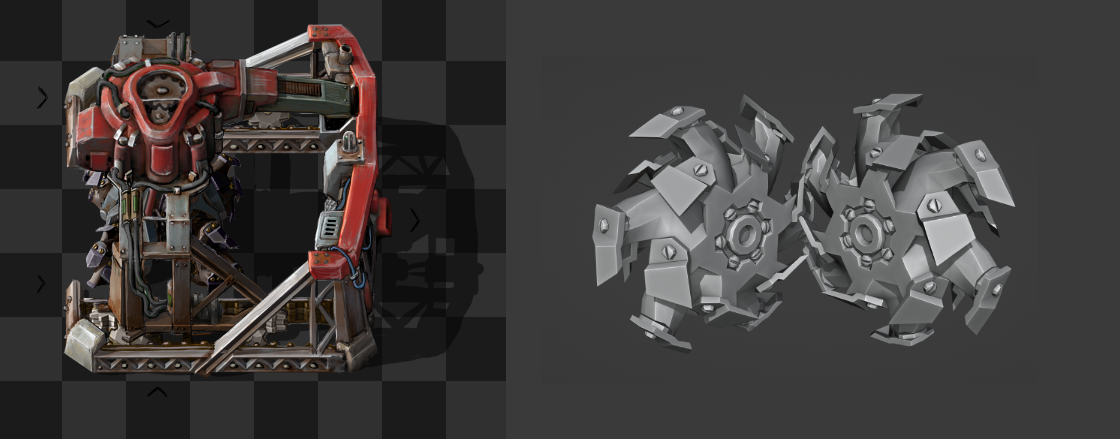Hello,
In the last FFF-386 we covered the natural landscape of Vulcanus which mostly showed the visuals, but as you are probably aware we always put gameplay first. Now it's time to find out what kind of greater good you can do to the planet...
Early in 2021 when kovarex and I were trying to make a high-level general plan of what the expansion should be, it was obvious the direction leads upwards to space, which in our eyes kind of automatically meant also visiting other planets. The obvious next question would be, what is a planet, what does it mean, how is it different from Nauvis, and how many of them do we want?
In Factorio, progression has always been linked to science, so it is intuitive that every new planet would yield a new science pack, unlocking more parts of the technology tree. This often means a lot of progress is very linear, with some exceptions that you can choose to progress in a different order (utility/production science), but ultimately you arrive to a single goal at the end. So we knew one planet has to be the last.
Since a significant part of the expansion is the space platform with space logistics, it's hard to imagine an expansion with only one planet, in fact we think less than 2 or 3 additional planets isn't quite making good use of the space logistics. This left us with 4 new planets as the sweet spot between satisfying progression and minimal repetition.
As we've already mentioned, while it's easy to assume that Nauvis would remain to be the location of the main factory for most players, we really wanted to avoid the situation where the new planets become just mining outposts. We wanted the player to build something that feels like a worthy factory on each of the planets.
After you land on a planet, you need to launch rockets again in order to get back into space. At the start this is more of a throwback to again experience the stranded feeling. This time the process is already greatly accelerated since you have all the technologies and your space platform can bring you a lot of construction materials. However, building the rocket infrastructure 4 times starts to feel repetitive, so we definitely aimed to have each of the planet's recipes simplify or completely skip some parts.
The expansion generally puts a lot more emphasis on the stability of your factory, but it's Factorio and some things always go wrong. It's easy to imagine your Nauvis or space platforms aren't having the best time while you're on a different planet. To prevent locking your progress if Nauvis gets cut off or completely overrun, we need to include a way to craft pretty much all of the rocket parts on any planet.
All of this combined means that when finding the theme and resources for planets, they should generally slot into some area of Factorio in a nice way, while being fresh and unique too. And because we apparently just love contradictions, we want an experience that feels new without having to learn too many recipes per planet.
On top of that, adding new recipes was made even more difficult due to the recycler, which was already in the game as a part of the quality branch before we started work on any of the planets. If an item has alternative recipes, it's not clear which ingredients should be returned on recycling this item. This makes adding alternative recipes pretty much a no-no.
We had a rough plan on how many planets would we like, some general limitations we knew we needed to follow, and some disconnected ideas for mechanics and features. Then we asked Earendel to attempt to fill these brackets with both visual and gameplay themes which, apart from the planet terrain you've already seen, translates into new recipes and machines.
The main crafting theme of Vulcanus is metallurgy, and this large structure is its main representation.

Heavy, industrial, powerful. Often it's enough for Earendel to create concept art "just" by drawing in 2D, but this machine has a lot of massive moving parts with a lot of rotational movement, looping animations, and space restrictions for each part. This made Earendel block out most of the main shapes in 3D, and do so in a lot more detail than usual (left). Later he would do a new drawing over the grey render to figure out the details and textures (right).
From there is was down to Jerzy to build this monster into its final form:
You can probably tell Jerzy had a good time.
A lot of work also went into the sound design between Ian creating the sounds and Donione implementing a new system for how entities can play sounds. I'm sure you can expect a FFF about that one beautiful day, for now we can just marvel at how the Foundry looks and sounds.
From the visuals it is apparent it's going to require a lot of energy to run, but what do we get for the investment?
The Foundry can handle molten metals or even lava itself. The unique recipes on this planet are about tungsten processing, which eventually leads into the Metallurgic science pack made in this machine.

It's been mentioned above how alternative recipes are a problem in part due to recycling. This isn't the case for smelting and chemical processes, as the recycler returning ingredients of these transformative recipes just doesn't make any sense. So, recycling an iron plate will just return an iron plate, with 25% chance.
This is important because we can have the foundries use different recipes for smelting without any issues. Bringing the Foundry back home to Nauvis or any other place feels very rewarding because it crafts very quickly and you can start distributing molten iron and copper instead of the finished plates.
Better yet, from the molten iron and molten copper we can cast more advanced items like iron gear wheels, copper cables, or even steel directly. Recycling an iron gear wheel will still return iron plates but it's less efficient than making the iron plates from molten iron straight up.
And because we want to make specifically the rocket part production easier, the Foundry can also craft the normal recipe of Low density structures. Copper and Steel plates for the Low density structure are much easier to craft too.
Perhaps the biggest advantage is that the Foundry has a built-in 50% productivity bonus, which can be further boosted with the machine's 4 module slots.
Tungsten ore is hard to mine and normal mining drills aren't capable of it. At the start you can find tungsten ore in rocks all over the surface of Vulcanus, but with this mining drill you can start to mine it in large quantities the way we like it.
The new usurper of natural resources, the new exploiter of planet surfaces, the new cause of mass pollution, powerful enough to mine Tungsten ore.
Mining drills are an essential part of Factorio, I would even argue it's one of the most important entities. Side by side to the iconic assembling machine for crafting, there is the mining drill for planet exploitation and devastation of environment.
This means we've put a lot of thought into the visual design. The keywords for the electric mining drill we redesigned in 2019 were "aggressive ground penetration", violence and power exerted against the soil. We have followed this direction again, but wanted to exaggerate all of these even more and represent that it can wreck the land faster and in a bigger area.

Being bigger and more massive tends to invite making the entity taller, but if you remember we have already walked this path before with the Electric mining drill - while we soon after realized we need to attach it to the ground more so we did in the last minute before 1.0 release.
For the mining mechanism itself we chose a set of four excavating wheels which circulate inwards where the ore is being sucked in by the mechanism above.
We have doubled down on the ground-attached rails that the mining head travels on and we have raised the holding structure in the direction of the output which gives the drill directionality and a taller presence than the Electric mining drill.
Once we had agreed on the design and Earendel finished the concept art, we let Jerzy off the chain again.
It would be pretty weak if the only use of the Big mining drill was to just get Tungsten, so it is also a direct upgrade from the normal mining drill in several ways:
Additionally it has a special unique property, the reduction in resource drain by 50%. This new stat means the resource underneath only gets its richness depleted half of the time. In other words, this directly multiplies with the productivity of the drill and you can imagine how crazy mining productivity can get. Better yet, the resource drain % is affected by quality of the drill, at Legendary quality a Big mining drill only drains the resource 17% of the time. Such a drill is mighty expensive but that resource patch you're about to place them on sure is going to last for a while.
Apart from these two structures and tungsten processing, Vulcanus has some more differences compared to Nauvis.
Most of the initial rules and ideas, together with Earendel's great work on the first prototype version still remain on Vulcanus to this day, we have just refined the experience over time.
When you're focused on designing individual systems you always aim to get a sophisticated result with intricacies and cool complexities. A small amount of increased complexity was one of our early objectives, but we found that after adding alternate resource sources, new sciences, and new gadgets, then it was already complicated enough. When you play the game as a whole you need to automate and take care of so many things which can quickly become overwhelming.
The initial gameplay prototype included more intermediate items and mechanics than we have now, like tungsten would first need to be turned into powder before being processed, any kind of melting and casting recipe would also output slag which was used for nothing but reprocessing (back then we couldn't void items in lava). If an intermediate is only ever used for one thing then perhaps it should be more useful or be removed. Both of these items ended up in a situation where they only slowed down progression, so they were removed.
On the other hand, the idea to extract iron and copper ore from lava was something the first prototype did include and we discarded it. After some time, we have realized that just mining iron and copper ore again the same way as on Nauvis isn't very appealing, so it eventually made it back in.
If you have to build multiple bases then it's important to reduce points of repetition between planets so that nothing feels stale. Over time we have consistently tried to simplify and cut excessive things. If something is repetitive but can't be cut, then we can add a new twist or a new shortcut instead. This has been the case since Earendel's initial version and every iteration since, so now we can get through all the planets while keeping the gameplay fresh.
Everything presented above is obtained from trigger technologies which ask the player to craft some item specific to Vulcanus. While the Foundry and Big mining drill are very exciting when you start using them on planets other than Vulcanus, we still haven't shown what you could unlock with the Metallurgic science pack... Perhaps some other time!
Please feel welcome to come melt our hearts with your beliefs that only children use the word "Big" for machine names, you won't be wrong.